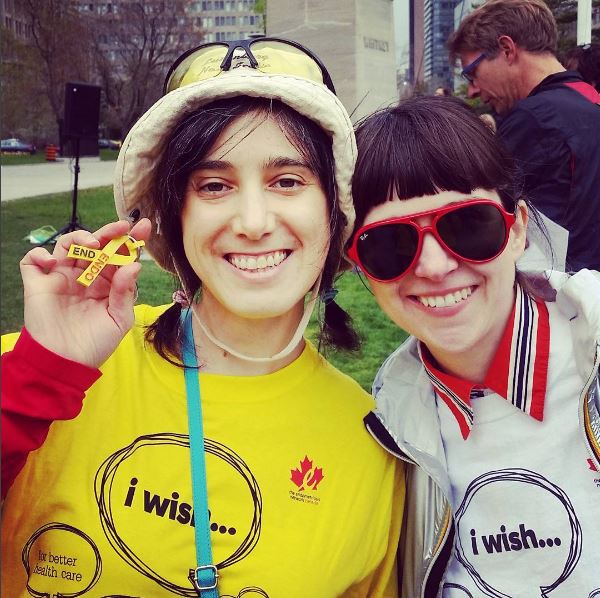Julia Ruth West Ross (1983-2013)
Julia, our middle daughter, lived in Southern California while earning an M.A. in Economics at UC Irvine. She enjoyed Southern California because there was so much she liked to do there. She loved camping, beach trips, Mexican food, music concerts, hanging out with friends, beer tasting, and her two cats. She started working at her first professional job in 2011 and she then met her husband Eric. Julia and Eric had just married and were so excited to be in their new apartment and all of us were so happy for them. It was a wonderful time.
Julia called me on Tuesday night on her way home from work. She was looking forward to the upcoming weekend as she was getting things packed for their delayed honeymoon cruise that coming Sunday. She was so happy.
Eric and Julia were married for just under five weeks when I got a call two days later from Eric that Julia was in the Emergency Room.
Early Signs of NuvaRing Clotting
Eric told me that Julia had been feeling tired for a few days, but that on Wednesday night, as she walked to her car after work, she felt faint, had tunnel vision and was short of breath. She got home and climbed into bed early. Usually full of energy, this was not like Julia, and Eric was surprised when he came home from work to find the house dark and Julia in bed. She told him she felt really tired and nauseous. He later told us that night “she threw up once or twice but it was mostly just dry heaving with just a little bit of liquid, the liquid though was very dark. Also, she had not eaten very much the last few days. I don’t remember the exact details but I think she had hardly eaten the day before and may not have really eaten that day either. If she did eat, it was a very small amount.” She also had diarrhea.
Thursday morning, thinking she had the flu; Julia stayed home from work, another unusual thing for her. Later that morning she called Eric, asking him to take her to an Urgent Care. She was feeling worse. She couldn’t breathe, felt very weak and faint. Eric rushed home and took her to Urgent Care.
At Urgent Care they saw she was in respiratory distress. Her blood pressure was low and her heart was racing. As they were preparing to intubate her, she fainted. They completed the procedure and transported her to the Emergency Room. We read later in her medical records that she told them she felt “a sense of impending doom,” and we also read that the ER doctor removed a NuvaRing.
Eric called again much later that Thursday night to tell us the doctors wanted to put Julia in the ICU and asked him if her parents knew. He also told us that the doctor said her kidneys weren’t functioning and they wanted to put her on dialysis. This was more than a standard emergency room visit. The ICU? Kidneys not functioning? Dialysis? Do her parents know? We didn’t know what to think. Alarmed, worried, and not understanding what was happening, my husband and I flew the 450 miles to be with Julia.
We arrived at the hospital on Friday morning, and saw Julia briefly. She was sedated, so she didn’t know we were there. The nurse sent us to the waiting room because she needed to do some things in the room. Waiting seemed to take forever.
Sepsis or Missed Pulmonary Emboli?
An hour later the ICU doctor came to tell us that they thought Julia had septic shock and they had put her on a sepsis protocol, giving her antibiotics and antifungals to treat any infection. They also had her on vasopressors to help increase her blood pressure. They were also trying to get a dialysis machine set up.
The ICU doctor assured us that Julia would recover, saying, “Julia is young and strong.” The doctor seemed very confident as she explained that Julia would be in the ICU for a few days and moved to another floor to recover for a week or more. The doctor sounded so sure of herself. We were still anxious and just wanted to be with our daughter. Her dad and I again were allowed to see Julia briefly although we were told again that we needed to wait in the waiting room as they were setting up equipment. We waited with Eric, his parents and sister. We cancelled the cruise trip, thinking it was just a postponement until Julia got better.
An hour later, a nurse ran into the waiting room, yelling, “West family, we need you NOW!” and rushed us down the hall to Julia’s room. The ICU team was frantically doing CPR on Julia. Shocked, we huddled together in the doorway, clutching each other, as we watched the medical team frantically work on Julia.
The ICU team stabilized Julia and we all breathed a sigh of relief and moved out into the hall. Calm was restored to the room and the staff began drifting off to other tasks. Julia went into cardiac arrest again. Again we watched the team rush to perform CPR. We stood outside a set of large sliding glass doors to Julia’s room, with disbelief and increasing dread until Julia’s heart was again stabilized. Calm lasted for what seemed like minutes. Again and again Julia went into cardiac arrest, one after another for over four hours. The ICU team kept up their heroic lifesaving efforts to resuscitate and stabilize her.
One of the doctors on the team told us that we’d have to make a decision at the end of the next hour as to whether to continue resuscitation. We’d been in the hallway for hours and we were told that Julia’s chance of being severely brain damaged was 95% because her blood was so very thin and she’d had so little oxygen to her brain. At the end of that last hour, we reluctantly and painfully told them to stop. We felt we had no option but to let her go. We believe Julia wouldn’t have wanted to live a diminished life, even if they could have saved her. The staff stopped their efforts and left the room for us to gather around Julia’s bed. Within ten minutes of stopping CPR, she was gone.
Asking Why
We left the hospital profoundly shattered and in shock. We had been told that she had septic shock, but we couldn’t understand how that led to her death. We wanted to know what had happened to our wonderful daughter. We requested an autopsy, as did the hospital. We also ordered Julia’s hospital records.
Later, my husband and I flew home. Julia’s husband, her sisters and brother were as devastated as we were.
The autopsy report stated that Julia died from massive bilateral pulmonary embolisms. The autopsy also showed she had a deep vein thrombosis (DVT) in her left leg. The blood clots in her lungs were so massive that no amount of resuscitation could have brought her back due to the massive clots blocking her lungs.
None of this made sense to us. Only the month previous, Julia had a health check up through her employer that showed she was healthy. Her blood pressure was normal, as was her cholesterol.
We wanted to know why our daughter developed pulmonary embolisms and a DVT. We discovered Julia was using the NuvaRing. We didn’t even know what a NuvaRing was. Our youngest daughter told us that she’d heard of women getting blood clots while on NuvaRing, so we began reading about the increased risk of blood clots for women on estrogen based birth control.
The ICU doctor told us that Julia had septic shock. We knew nothing about sepsis or septic shock. We wanted answers to everything, so we contacted the ICU doctor who had treated Julia and began asking questions, lots of them.
NuvaRing Induced Disseminated Intravascular Coagulation
We learned that Julia had been treated for a condition called Disseminated Intravascular Coagulation (DIC), a process characterized by the widespread activation of the blood-clotting cascade. We had to educate ourselves about DIC and found that DIC is caused by an underlying condition. The increased clotting in DIC uses up platelets and clotting factors in the blood. DIC can cause very small clots to form throughout the body’s small blood vessels. These small blood clots can reduce or block blood flow through the blood vessels, which can damage the body’s organs. When platelets are used up, the body isn’t able to stop bleeding, as the blood is thin due to lack of platelets. Had tiny clots formed in the small blood vessels in Julia’s body? Was this why Julia’s kidneys stopped working efficiently?
In reviewing the hospital records, we noticed that the hospital had done a CT scan of her abdomen, but they only did x-rays of her chest. We learned that clots do not show up on x-ray. A chest x-ray can find other diseases, such as pneumonia or fluid in the lungs but not blood clots.
The hospital had not done an ultrasound on Julia’s legs to look for a DVT, but leg pain or soreness was not one of Julia’s symptoms. We also looked for lab results for infection that might have caused sepsis or septic shock, but the lab records didn’t show any positive results for anything they tested for.
Julia had not complained of all the typical symptoms that you read about for a DVT or a pulmonary embolism. We learned that many people do not have the classic symptoms.
At that first phone call with the ICU doctor, after she reviewed the autopsy report, she told us they had not known Julia had pulmonary embolisms when she went into cardiac arrest.
NuvaRing and Julia’s Death
We asked the ICU doctor if the NuvaRing had anything to do with the pulmonary embolism. This doctor, who worked so hard to save Julia, was not familiar with the NuvaRing birth control and suggested we go to the company website for information. Her suggestion made me realize that she really didn’t know much at all about the NuvaRing. She told us that none of the lab tests had shown a cause for the sepsis. She also told us that the hospital would do a formal review of Julia’s case with a team of doctors, including those who had worked on Julia. The doctor couldn’t say more until after the formal review.
The hospital team eventually reviewed everything that happened to Julia, from her admission, treatment, and to her death. We spoke to the ICU doctor again after the review, and she told us she “did a lot of reading, a lot of research on the NuvaRing and strongly felt it had been a component in Julia developing such a massive pulmonary embolism.” She also explained that “a pulmonary embolism might have been brewing,” but that because Julia’s blood developed DIC her blood had become so thin that trying to surgically treat a pulmonary embolism would have caused her to bleed to death, and they couldn’t even give her anticoagulation treatment for the clot.
More importantly as to the cause of death, the ICU doctor told us,
We do not see someone as young and healthy as Julia develop such massive pulmonary embolisms unless there is an underlying factor… and that is hormonal birth control.
The ICU doctor said she and other doctors on the team,
Personally believe the NuvaRing caused Julia’s blood to clot and develop DIC as quickly and as much as it did.
This doctor went on to say:
In young patients like her, any time we see someone pass away from a massive PE like she did, it has never been just from an infection, never been just from sepsis.
It’s always been because of some underlying pathology that has caused the blood to clot the way that it does. Usually it’s an oral contraceptive pill, that’s 90% of the time, and 10% of the time it’s because there’s a genetic predisposition that went undetected or no one in the family had had that problem before. And we didn’t find out until much later.
Julia had been using NuvaRing for two years.
We believe the hospital staff did everything they knew how to do at the time. We truly thank them for all their efforts. But we also believe that they did not connect the dots about a pulmonary embolism forming or that hormonal birth control was causing the clotting that led to Julia’s death.
Our family will never be the same. Julia, our cherished daughter, sister and wife, was young, healthy, loving, vibrant and bright. She had a whole lifetime ahead of her. Julia had confidently used NuvaRing, a combination hormonal birth control, because it had been prescribed confidently to her. We share Julia’s story with our deepest hope that this won’t ever happen to any woman you love.
Dru and Joe West
Laura West, Marc Fish, Nancy Martin and Eric Ross
Photo: Julia pictured with her dad on the day of her wedding.
Real Risk Study: Birth Control and Blood Clots
Lucine Health Sciences and Hormones Matter are conducting research to investigate the relationship between hormonal birth control and blood clots. If you or a loved one have suffered from a blood clot while using hormonal birth control, please consider participating. We are also looking for participants who have been using hormonal birth control for at least one year and have NOT had a blood clot, as well as women who have NEVER used hormonal birth control. For more information or to participate, click here.












